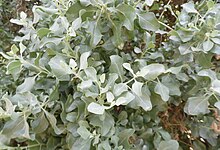Atriplex halimus
| Atriplex halimus | |
|---|---|

| |
| Scientific classification | |
| Kingdom: | Plantae |
| Clade: | Tracheophytes |
| Clade: | Angiosperms |
| Clade: | Eudicots |
| Order: | Caryophyllales |
| Family: | Amaranthaceae |
| Genus: | Atriplex |
| Species: | A. halimus
|
| Binomial name | |
| Atriplex halimus | |
Atriplex halimus (known also by its common names: Mediterranean saltbush, sea orache, shrubby orache, silvery orache; /ˈɒrətʃ/;[2] also spelled orach) is a species of fodder shrub in the family Amaranthaceae.
Description[edit]
The plant has small gray leaves up to 2.5 centimetres (1 inch) long. It resembles Chenopodium berlandieri (lamb's quarters).[3]
Distribution and habitat[edit]
The plant is widespread through the Mediterranean Basin, North and East Africa and the Arabian Peninsula.[4]
Ecology[edit]
The leaves are a dietary staple for the sand rat (Psammomys obesus).
Uses[edit]
The leaves are edible.[3] Extracts from the leaves have shown to have significant hypoglycemic effects.[5]
The species has potential use in agriculture. A study allowed sheep and goats to voluntarily feed on A. halimus and aimed to determine if the saltbush was palatable, and if so, did it provide enough nutrients to supplement the diet of these animals. In this study they determined when goats and sheep are given as much A. halimus as they like, they do obtain enough nutrients to supplement their diet – unless the animal requirements are higher during pregnancy and milk production.[6]
This plant is often cultivated as forage because of its tolerance for severe conditions of drought, and it can grow easily in very alkaline and saline soils. In addition, it is useful to valorize degraded and marginal areas because it will contribute to the improvement of phytomass in this case.
Use in antiquity[edit]
According to Jewish tradition, the leaves of Atriplex halimus are known in biblical Hebrew (see: Job 30:4) as maluaḥ (Hebrew: מלוח),[7] and which are said to have been gathered and eaten by the poor people who returned out of Babylonian exile (c. 352 BCE) to build the Second Temple.[8] Other classical Hebrew sources put the Mishnaic name of this edible plant as faʻfōʻīn (Hebrew: פעפועין), a plant that is explained to mean qaqūlei in Aramaic,[9] said to be the al-qāqlah (القاقلة) in Arabic.[10][11]
The Greek comic poet Antiphanes seemingly calls it halimon and refers to foraging for it in dry torrent beds.[12]
References[edit]
- ^ Korpelainen, H., Holubec, V., Asdal, Å., Magos Brehm, J., Labokas, J., Vögel, R. & Eliáš, P. (2011). "Atriplex halimus". IUCN Red List of Threatened Species. 2011: e.T176531A7260639. Retrieved 29 December 2020.
{{cite journal}}: CS1 maint: multiple names: authors list (link) - ^ "orache". Oxford English Dictionary third edition. Oxford University Press. June 2004. Retrieved 7 December 2018.
- ^ a b The Complete Guide to Edible Wild Plants. United States Department of the Army. New York: Skyhorse Publishing. 2009. p. 92. ISBN 978-1-60239-692-0. OCLC 277203364.
{{cite book}}: CS1 maint: others (link) - ^ "Atriplex halimus L." Catalogue of Life. Retrieved 29 December 2020.
- ^ Hypoglycaemic effect of the salt bush Atriplex halimus, a feeding source of Psammomys obesus
- ^ Valderrabano, J., Munoz, F., Delgado, I. (1996). "Browsing ability and utilisation by sheep and goats of Atriplex halimus L. shrubs". Small Ruminant Research. 19 (2). Zaragoza, Spain: 131–136. doi:10.1016/0921-4488(95)00754-7. Retrieved 13 April 2020.
{{cite journal}}: CS1 maint: multiple names: authors list (link) - ^ Mistranslated as "mallows" in the King James Bible and as Nesseln (nettles) in the Luther Bible
- ^ Babylonian Talmud, Kiddushin 66a, RASHI ibid., s.v. מלוחים.
- ^ Babylonian Talmud (Erubin 28a, Rashi s.v. פעפועין); ibid. (Kiddushin 66a, Rashi s.v. מלוחים); Jerusalem Talmud (Peah 8:4, where the plant faʻfōʻīn is identified as קקולי)
- ^ See the Judeo-Arabic lexicon compiled by Rabbi Tanḥum ben Joseph Ha-Yerushalmi (c. 1220–1291), entitled Murshid al-Kāfī (Bodleian Library MS. Huntington 621, frame 212r), where he explains פעפ"ע as meaning al-qāqlah (القاقلة), a plant identified as the shrubby orache (Atriplex halimus) in Amar, Z. (2012). Flora of the Bible - A New Investigation Aimed at Identifying All of the Plants of the Bible in Light of Jewish Sources and Scientific Research (in Hebrew). Jerusalem: Rubin Mass Ltd. p. 166. OCLC 783455868..
- ^ Cf. Bos, Gerrit [in German]; Käs, Fabian (2016). "Arabic Pharmacognostic Literature and Its Jewish Antecedents: Marwān ibn Ǧanāḥ (Rabbi Jonah), Kitāb al-Talḫīṣ". Aleph. 16 (1). Indiana University Press: 186. doi:10.2979/aleph.16.1.145. JSTOR 10.2979/aleph.16.1.145. S2CID 171046217.
"Mullāḥ (= saltwort). Abū Ḥanīfa said: A certain Bedouin told me that it is a variety of ḥamḍ (= sea-blite; saltwort) resembling al-qullām and it is (also called) qāqullā (= Atriplex halimus). A certain Syrian Bedouin told me: Al-mullāḥ resembles alkali plants (ušnān = Seidlitzia rosmarinus). Cooked together with milk, it can be eaten; it is sweet and not salty. Its seeds can be collected like faṯṯ-seeds; they can (also) be eaten baked as bread. I assume that it was called mullāḥ (lit. 'the salty') because of its color and not because of its taste." (Ibn Ǧanāḥ, Talḫīṣ, fol. 50r14–v6; ed. No. 549).
- ^ fr. 158 Kassel-Austin

